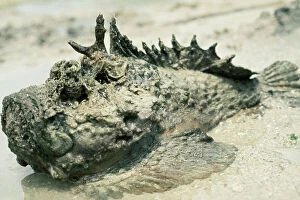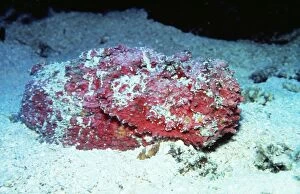Stonefishes Collection
Stonefishes, also known as spiny devilfish or stingfish, are fascinating and dangerous creatures that inhabit the depths of our oceans
All Professionally Made to Order for Quick Shipping
Stonefishes, also known as spiny devilfish or stingfish, are fascinating and dangerous creatures that inhabit the depths of our oceans. With their venomous spines and incredible camouflage abilities they can truly masters of deception. One captivating image shows a Stonefish VT 5 Poisonous in all its glory. The photograph captures the intricate details of this creature's body, highlighting its unique features and deadly beauty. Its poisonous nature is emphasized by Valerie Taylor's expert photography skills. In another picture, an adult Spiny Devilfish can be seen walking on sand with modified pectoral fins. Its spines erect and ready to strike at any moment, it moves gracefully across the ocean floor. This display showcases the adaptability and agility of these remarkable creatures. A Red Spiny Devilfish buried in black sand catches our attention in yet another photo from Lembeh Straits in Sulawesi. Its menacing spines stand tall against the dark background, blending seamlessly into its surroundings. It serves as a reminder that danger lurks where we least expect it. The vibrant colors of an adult Spiny Devilfish's extended fins create a mesmerizing warning display captured beautifully in one snapshot. This visual spectacle serves as a clear signal to potential predators: approach at your own risk. A close-up shot reveals the intricate head structure of a Red Spiny Devilfish during nighttime exploration in Lembeh Straits. The detailed patterns on its skin add to its mystique while reminding us that even under cover of darkness, these stonefishes remain vigilant. Moving away from devilish appearances but no less intriguing is the Blue-eyed Stingfish resting peacefully on black sand off Sulawesi Island. With eyes like sapphires sparkling against its muted surroundings, this species captivates with its ethereal beauty. Venturing beyond Indonesia's waters brings us face-to-face with Reef Stonefish found in the Red Sea - showcasing how stone fishes have adapted to different environments.















